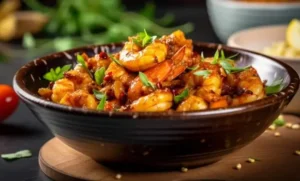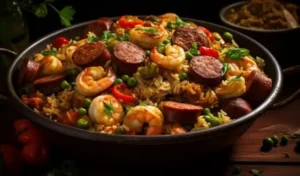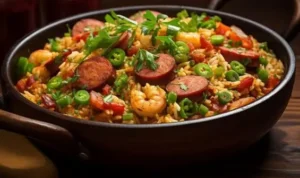Mastering the Art of Traditional Jambalaya

Get your taste buds ready and learn more about the original recipe of jambalaya with this journey across the ‘heart of Louisiana’. This delectable dish has always brought together delicious combinations of spices, meats, and vegetables, for generations now. Here are a few tips to ponder as you embark on the journey of making real jambalaya mix: With the help of our guide, you’ll discover how the jambalaya recipe gets its rich taste, and how all the components interconnect. This guide will provide you not only with important information about choosing rice for your jambalaya but also with tips on how to layer the flavors properly to create a proper Creole/Cajun dish. I have 20 years of experience in cooking. So you can trust me.
The History and Origins of Jambalaya
From Spanish Paella to Creole Classic
The history of the jambalaya recipe easy Let the staple dish of Louisiana be the product of the mixed culture of the region and an important part of its identity. This delicious rice dish was first invented in the late 18th century when the Spanish tried to adapt their traditional dish, paella, to the new world. Not being able to find standard ingredients such as saffrons to give the dish its more distinguishable colors and flavors, they substituted them with tomatoes, which eventually gave way to Jambalaya.
A Fusion of Cultures
As the dish developed they added some of the characteristics of French, African, and Native American dishes into the dish’s preparation. The name for this dish – simply cook jambalaya – is believed to have been derived from ‘jambalaya’ – a Provençal term that translates as ‘mix-up’ or ‘mingling’. This in a nutshell defines the dish’s character as a delightful fusion of several different cultures.
Regional Variations
Over time, two distinct styles of jambalaya ingredients emerged: Creole and Cajun. The tomato-containing ‘red jambalaya’ is one of the variants of the Creole jambalaya and belongs to New Orleans. There are two types of authentic jambalaya recipes—cajun jambalaya or “brown jambalaya,” which does not use tomatoes and is mostly found in rural areas. Each version highlights how resourceful Louisiana cooks were to create such a protein, satisfying, and tasty meal using ingredients that could easily be found nearby.
Key Ingredients for Traditional Jambalaya

The Holy Trinity
At the heart of any authentic jambalaya lies the “Holy Trinity” of Cajun and Creole cuisine: Onion, celery, bell peppers, and so on. This aromatic base builds the foundation around flavor and provides the dish with that distinct Louisiana twang. Cut into very small pieces and cook in the frying pan until they get soft, they add a nice additional flavor to the rest of the dish.
Protein Power
The traditional form of jambalaya simply cooking uses a lot of meat that is incorporated into the menu. Andouille sausage, the smoked and spicy cured pork sausage, is a necessity of course. Thighs are the next favorite because they are delicious and because they hold a lot of liquid within them. To give it an Asian flair, it is possible to put shrimp or crawfish instead, which will make the dish sweet.
Rice and Seasonings
white cooked long-grain rice is the kind that forms the base of chicken jambalaya. When it comes to spices the mixture of paprika, cayenne pepper, thyme, and oregano gives the meal authentic spicy Cajun zest. You also have to include the bay leaves as they add just a tad of an earthen taste to the dish. Tomatoes, although not mandatory especially when using NO’s, give acid and red color to Hello Fresh jambalaya red jambalayas.
Step-by-Step Instructions for Making Perfect Jambalaya

Prepare Your Ingredients
Also, you must assemble all your ingredients. Dice the “holy trinity” of Cajun cooking: leaf lettuce vegetables include onions, celery, and green bell peppers. Cut your chosen meats, andouille sausage and chicken into cubes. Here is your rice ready, your stock, and your spices measured to go into it.
Build the Flavor Base
Cook with oil in it in a large, heavy-base pan. Browning the vegetables of the so-called holy trinity followed by sautéed minced garlic. Mix meats into your sauces and cook until they are brown. It is this process that lays a good taste for your jambalaya.
Add Rice and Liquid
Add your rice into the pot and stir up because you would want to cook it with the oils that are remaining in the pot. Incorporate your stock, and/or crushed tomatoes if you are using them. Control of this parameter is very important to make proper consistency of the food Liquid ratio to the rice is very important.
Season and Simmer
As we are sliding towards the end of cooking, it is the perfect time to give your meat the Cajun seasoning, thyme, and bay leaves. After that, the mixture is to be boiled and then allowed to stew. Pour and cover and allow to steam for 20-25 minutes, or until the rice is soft and has puffed up and the liquid has been fully absorbed.
Final Touches
Mix up the best jambalaya recipe gently with a fork and then let the food sit for around 5 minutes before consumption. This causes the flavors to combine because they are not WSET and the texture becomes set. Sprinkle with chopped green onions, and serve hot, for the most Southern Louisiana experience.
Tips and Tricks for Adding Flavor and Spice

Layer Your Flavors
In this recipe for the perfect shrimp jambalaya recipe, making use of layers of taste is critical. First, for a little flavor, in a little oil, sauté the holy trinity of Cajun cooking, which is onions, celery, and bell peppers until they’re softened. This results in the production of a good flavor that enhances your dish. Third, incorporate all your proteins and spices stirring until they caramelize and release their numerous favorable aromas, then incorporate your rice and liquid.
Spice It Up Wisely
The spice blend turns out to be a very important aspect of easy jambalaya. Ingredients listed as cayenne pepper, paprika, and thyme need to be used but do not be rigid to their use. A Sprinkle of fine powder can enhance the taste and a speck of hot sauce can make it hot. Also, Ç an’t put out a fire with spice once it is added but improves taste when added a bit at a time and then builds up.
Perfect Your Roux
To add a true taste of Creole, it may be worthwhile to include a dark roux. This mixture of flour and oil, cooked until it turns the color of milk chocolate dispenses a splendid, nutty flavor to your Aldi jambalaya recipe. The primary mistake is impatience—only consistently stirring the mixture will yield the perfect roux, which takes time but is worth it.
Common Jambalaya Mistakes and How to Avoid Them

Overcooking the Rice
One of the common mistakes people make while preparing all recipes for jambalaya is usually overcooking the rice. This can lead to a soggy texture that is almost revolting to even look at much less eat it. To prevent this you should be very careful with the time you spend boiling the rice and the ratio of liquid you use in boiling the rice. Remember, the rice should be soft to soft but I can still feel the little hardness when I am eating it.
Neglecting the Holy Trinity
The three important ingredients that are holy in Cajun recipes and go into America’s test kitchen jambalaya ingredients include onions, green bell peppers, and celery. There are issues with these ingredients and often people skip adding at least one of these ingredients or add very little of it and that is why, the result does not look quite as appetizing and genuine as it should. This is always important to ensure that before adding other foods you are certain they have undergone the sautéing process of these aromatics.
Rushing the Process
amazing jambalaya recipe is an example of a meal that better be prepared with lots of time to spare. Cooking at high speeds is a big mistake that hinders the proper cooking of vegetables and the proper development of the other ingredients in the food. Take sufficient time when constructing the base flavor and the final dish preparation as well as when boiling the final meal. This slow-and-steady approach will pay off when you have a homogenous and tasty authentic chicken jambalaya recipe. Whilst one will take longer than the other, both methods will make a jambalaya and the best one depends on individual preference.
Improper Seasoning
Some of the issues important for a good seasoning in authentic jambalaya include the following. Using too little seasoning makes the food taste plain while use of excessive seasoning distastes the food since the appropriate balance of flavors is interfered with. Taste the stew as you go and ensure that you remember that its flavors will deepen as the stew cooks.
Conclusion
Walking through your jambalaya Homemade recipe 2024 adventure, do not forget that owning the recipe of this traditional plate is a lot more than simply ingredients and a method to cook. It’s about taking the essence of Louisiana cuisine and making it what you will…nobody here is going to tell you how to do it. As you go on, it will become second nature to find a harmony of flavors and get that all-important texture right. As a chef, don’t be scared if you have to mix a new ingredient or try a new method, but do not forget the history of the dish. Whether you are feeding your family and friends or indulging yourself, a pot of jambalaya Recipe to Make at Home of your making will take you straight to the great streets of New Orleans. Well fire up your stove, let the smoke fill your kitchen, and enjoy the thousands of years of cooking you are now included in.
FAQs
Is jambalaya spicy?
Jambalaya as a normal recipe can be hot, but one can adjust the spiciness depending on one’s preference. Garlic, ginger, and chili are often added to foods and many recipes contain cayenne pepper or hot sauce. Nevertheless, you may alter the spiciness level to a level that is more appropriate with a simple deletion of these substances.
What’s the difference between Creole and Cajun jambalaya?
The main difference, as such, is with the tomatoes being used. Red jambalaya or creole jambalaya which is one of the Jambalaya variations uses tomatoes as an ingredient. Cajun jambalaya or ‘brown’ jambalaya is cooked differently with tomatoes excluded and the meat is seared in the pot.
Can I make jambalaya in advance?
Absolutely! Jambalaya is better when it has been made a day ahead and then reheated because the flavors can blend. All you have to do is to heat it gently over the stove or oven, possibly add a little stock to soften up the thickness. This makes it a perfect option for a meal prep or a party since it has multiple uses in one pan.
About Us:
Mastering the Art of Traditional Jambalaya
Traditional Hot Dogs Recipe to Make at Home
Philly cheesesteak Sandwiches recipes 2024
